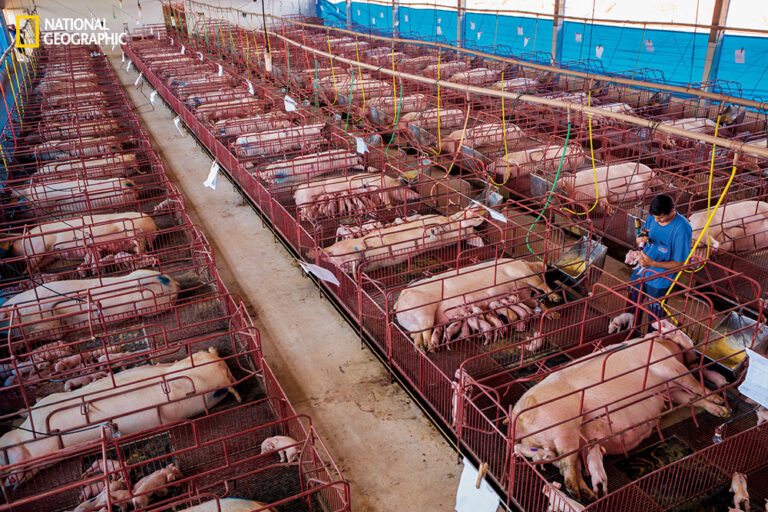a history of domestic (American) agricultural policy

Although much of the original motivation to settle America was fueled by a divine imperative to ‘go forth and conquer’ in the name of God, domestic farm policy also played a large role in motivating both citizens and newly arrived immigrants to settle the lands of the vast unknown.
This began in the 1800s when domestic policy in the United States served to incentivize and support family farmers as it was believed they were an asset that would contribute to the establishment of a strong nation (SPITTLER et al. 2011). The Land Act of 1820 offered land at a reduced price to encourage citizens to move Westward and explore and develop the arable land. The Homestead Act of 1862 allowed farmers to cultivate any unclaimed territory, thereby enabling them to become property owners. In the same year, the Morrill Land-Grant Colleges Act was introduced to create a system of universities focused on agriculture that would be accessible to everyone at a reasonable cost (PARR et al. 2007).
By the early 1900s, during the first World War, farmers monopolized on the situation in Europe and opted to increase their production output to meet the continent’s growing demand. However, when the war ended, demand dropped sharply leaving domestic farmers without a market for their surplus crops. The government subsequently opted to provide relief aid to Germany and some areas in Russia with the extra product. Shortly after, the Great Depression led to another massive price drop in crop prices, an issue compounded by technological growth that served to reduce the amount of farm labor required. In a flawed attempt to rectify problems with production, the Agricultural Adjustment Act (AAA) of 1933 ordered the discontinuation of surplus production (WENDER 2011).
At that point in time, the United States Department of Agriculture (USDA) was put in charge of the oversight of agricultural policy. It subsequently ordered the destruction of innumerable crops and livestock, placed restrictions on commodity production, and authorized direct and indirect payments to farmers. Instead of addressing infrastructural issues, these actions caused the prices for necessities to become excessively high in a time when millions of citizens were suffering the effects of the Great Depression. More simply, there was a gross misallocation of resources that, in the end, hurt both farmers and society in general. These decisions also resulted in the elimination of sharecroppers from the American landscape as a response to the distribution of payments from the government that would have required sharing with tenant farmers, prompting landowners to hire wage laborers (SPITTLER et al. 2011).
The AAA was ruled unconstitutional in 1936, and a new version was introduced in 1938 that earmarked subsidies for commodity crops to avoid fallouts similar to those in the period following the first AAA. These subsidies were designed to provide both low-cost food to a struggling and hungry nation and wean the country from its addiction to overproduction but instead started a new addiction to government subsidies (WENDER 2011). New technologies introduced post-World War II exasperated the problem (SPITTLER et al. 2011).
Nonetheless, for a time, America’s economy flourished but was once again sluggish by the early 1970s as economic expansion slowed. Stagflation, characterized by a stagnant economy and high inflation, ensued and was highlighted by the recession from 1973 to 1975. To counteract slow economic growth, a new brand of liberal trade policies, supposedly capable of preventing the problems caused by the first wave of trade liberalization, was promoted and ultimately adopted. This point marked the dawn of the age of neoliberalism.
As already stated, it was purported that this new brand of liberalism would alleviate the problems not solved by the original flavor of liberalized trade. Achieving such results required rejecting socially-liberal policies and embracing political and economic restructuring via privatization, deregulation, and support for globalization (REYNOLDS AND SZERSZYNSKI 2012).
ALKON and MARES (2012) explain that neoliberalism goes beyond being just an approach to politics. Instead, they describe it as an all-encompassing political and economic philosophy that embraces the market, rather than the government, as the mechanism to satisfy all human needs (ALKON and MARES 2012). In turn, the influence of market conditions becomes pervasive not only in communities but also in individual lives by ingraining the importance of individualism, efficiency, and self-help (rather than systems, efficacy, and community).
The ultimate objective of this restructuring is to achieve maximum (economic) efficiency enabled via the free flow of capital. It is essential to understand that, despite many of the changes associated with neoliberalism being considered a narrow subdivision of economics concomitant with monetarist and supply-side economics, neoliberalism itself has since come to embody a broader political ideology (HESS 2012). HESS (2012) describes this as a cultural model favoring limited government via the admonishment of the central governing body, decision-making by markets, and a general rejection of a collective mentality in favor of an emphasis on the importance of self-responsibility. This change, while masked as a rejection of government intervention, is an attempt to restructure the economy and arguably society in general to fit a pre-designed model. This served to reduce transaction costs by changing the principal-agent relationship to manipulate relationships to demand compliance with this so-called ideal.
Accordingly, many institutionalized changes have emerged, with financialization being a significant component of this evolution. In this case, financialization refers to the shift from gaining returns on capital from production and the exchange of commodities to gains from financial innovations, e.g., futures and derivatives (HESS 2012). In other words, money could now be used to generate profit directly through interest or speculation, rather than investments in infrastructure or commodity production. The result of which is a concentration of financial resources by evermore aggregated corporate entities (HESS 2012).
In the United States, the agricultural sector was particularly sensationalized by this advancement, which encouraged unprecedented investment and outstanding levels of debt financing by farmers (BARNETT 2000). With the infiltration of neoliberal ideas into the American policy environment, the government opted not to support family farmers. In fact, by the mid-1970s, the federal government openly denounced small and family farms in favor of large-scale, industrialized operations (SPITTLER 2011), with the then Secretary of Agriculture Earl Butz, even being quoted as saying that farms should either, “Get big or get out.” At the same time, the nation’s first agricultural lobby entered the scene, laying the infrastructure for the tight-knit relationship between political bodies, food processors, and large-scale producers (WENDER 2011).
These changes ultimately led to extensive farm consolidation, increased commodity production, a shift towards the consumption of what NESTLE (2007) calls “Frankenfood,” i.e., food that is so processed that it barely resembles its original form, and a general trend disfavoring small and family farms. A precursor to embracing this shift towards super-sized farming operations was the adoption of neoliberal agendas that encouraged commodity production and the restructuring of production methods to cater to the export market. In doing so, agricultural communities began divesting (both literally and concerning ‘social capital’).
For a while, farmers reaped enormous benefits. From 1969-1978, the value of farm holdings increased 73% from $519 billion to $900 billion, and many believed that investment in agriculture was the ‘perfect hedge’ against inflation that was plaguing the country (BARNETT 2000). Combined with new technological advancements supported by the Green Revolution and technoscientific methodology, the United States readied itself to “feed the world.” Farmers then began buying up large tracts of land via debt financing that was seemingly supported by rapidly rising farm and commodity values (in 1978, only 11% of farm real estate transactions were conducted without debt financing, compared with 42% in 1950 (BARNETT 2000).
However, prices began leveling off in the early 1980s, with the period from 1981 to 1986 being the worst period for agriculture since the Great Depression. Due to the massive speculation and the agricultural “boom,” land prices became excessively high, and farmers faced cash flow problems. When prices began dropping, farmers struggled with debt. Reagan then promoted supply-side economics which was expected to solve the obstacles at hand but only caused commodity prices to sink rapidly, with 1983 being the lowest figure on record for net farm income since the USDA began tracking the revenues in 1910. Land prices dropped up to 50%. All of these problems together caused half of all farmers to go out of business (USDA 2017).
In response to the economic hardships faced by farmers, the United States increased direct payments to farmers which accounted for 31% of net farm income between 1985-1988. This trend has remained and the nation’s policy preference for large-scale production has remained blatantly obvious. For example, according to the USDA (2017), large commercial firms with gross annual sales ≥$250,000 received 62% of all government payments, while small rural residence and intermediate farms each received only 19% although they represent ca. 75% of the subsidized farming market. Similarly, from the period from 1995 to 2010, 77% of all farm subsidy payments went to the top 10% of America’s subsidized farmers (EWG n.d.). Laterally, the agribusiness lobby has become one of the largest in the nation, granting it a great deal of political influence. For example, during the 2016 election season, the agribusiness lobby donated $116,389,035 to political candidates (CENTER FOR RESPONSIVE POLITICS 2018). These exchanges of money, which in the broadest sense of the term are systems of welfare, are demonstrative of the existing social order (BYRNE 1994).
sources:
- Alkon, A. H., & Mares, T. M. (2012). Food sovereignty in US food movements: radical visions and neoliberal constraints. Agriculture and Human Values, 29(3), pp. 347–359.
- Barnett, B. (2000). The U.S. Farm Financial Crisis of the 1980s. Agricultural History, 74(2), pp. 366-380.
- Byrne, D. (1999). Social exclusion. Buckingham England Philadelphia: Open University Press.
- Center for Responsive Politics. (2018). Annual Lobbying by Agribusiness.
- [EWG] Environmental Working Group. (n.d). Total USDA Subsidies.
- Hess, D. (2012). The Green Transition, Neoliberalism, and the Technosciences. Neoliberalism and Technoscience: Critical Assessments, pp. 209-230.
- Nestle, M. & Pollan, M. (2013). Food politics : how the food industry influences nutrition and health. Berkeley, Calif: University of California Press.
- Parr, D. M., Trexler, C. J., Khanna, N. R., & Battisti, B. T. (2007). Designing sustainable agriculture education: Academics’ suggestions for an undergraduate curriculum at a land grant university. Agriculture and Human Values, 24(4), pp. 523–533. https://doi.org/10.1007/s10460-007-9084-y.
- Reynolds, L. & Szerszynski, B. (2012). Neoliberalism and technology: Perpetual innovation or perpetual crisis?. Neoliberalism and Technoscience: Critical Assessments. 27-46.
- Spittler, J., Ross, .R., Block, W- (2011). The economic impact of agricultural subsidies in the United States. In The Journal of Social, Political and Economic Studies. 3(3), pp. 301-318.
- [USDA] United States Department of Agriculture. (2017). Farming and Farming Income.
- Wender, M. J. (2011). Goodbye Family Farms and Hello Agribusiness: The Story of How Agricultural Policy is Destroying the Family Farm and the Environment, Villanova Environmental Law Journal. 22(1), pp. 141-167.
image credit:
https://thesustainabilityalliance.us





2 Comments
Comments are closed.